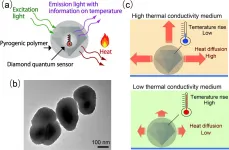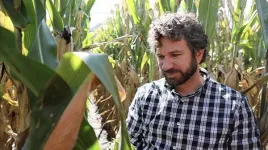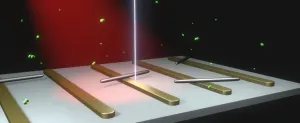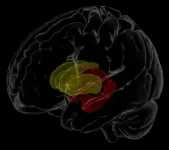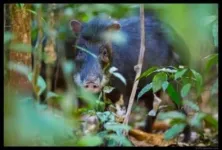Conductive nature in crystal structures revealed at magnification of 10 million times
University of Minnesota study opens up possibilities for new transparent materials that conduct electricity
2021-01-15
(Press-News.org) In groundbreaking materials research, a team led by University of Minnesota Professor K. Andre Mkhoyan has made a discovery that blends the best of two sought-after qualities for touchscreens and smart windows--transparency and conductivity.
The researchers are the first to observe metallic lines in a perovskite crystal. Perovskites abound in the Earth's center, and barium stannate (BaSnO3) is one such crystal. However, it has not been studied extensively for metallic properties because of the prevalence of more conductive materials on the planet like metals or semiconductors. The finding was made using advanced transmission electron microscopy (TEM), a technique that can form images with magnifications of up to 10 million.
The research is published in Science Advances, a peer-reviewed scientific journal published by the American Association for the Advancement of Science (AAAS).
"The conductive nature and preferential direction of these metallic line defects mean we can make a material that is transparent like glass and at the same time very nicely directionally conductive like a metal," said Mkhoyan, a TEM expert and the Ray D. and Mary T. Johnson/Mayon Plastics Chair in the Department of Chemical Engineering and Materials Science at the University of Minnesota's College of Science and Engineering. "This gives us the best of two worlds. We can make windows or new types of touch screens transparent and at the same time conductive. This is very exciting."
Defects, or imperfections, are common in crystals--and line defects (the most common among them is the dislocation) are a row of atoms that deviate from the normal order. Because dislocations have the same composition of elements as the host crystal, the changes in electronic band structure at the dislocation core, due to symmetry-reduction and strain, are often only slightly different than that of the host. The researchers needed to look outside the dislocations to find the metallic line defect, where defect composition and resulting atomic structure are vastly different.
"We easily spotted these line defects in the high-resolution scanning transmission electron microscopy images of these BaSnO3 thin films because of their unique atomic configuration and we only saw them in the plan view," said Hwanhui Yun, a graduate student in the Department of Chemical Engineering and Materials Science and a lead author of the study.
For this study, BaSnO3 films were grown by molecular beam epitaxy (MBE)--a technique to fabricate high-quality crystals--in a lab at the University of Minnesota Twin Cities. Metallic line defects observed in these BaSnO3 films propagate along film growth direction, which means researchers can potentially control how or where line defects appear--and potentially engineer them as needed in touchscreens, smart windows, and other future technologies that demand a combination of transparency and conductivity.
"We had to be creative to grow high-quality BaSnO3 thin films using MBE. It was exciting when these new line defects came into light in the microscope," said Bharat Jalan, associate professor and Shell Chair in the Department of Chemical Engineering and Materials Science, who heads up the lab that grows a variety of perovskite oxide films by MBE.
Perovskite crystals (ABX3) contain three elements in the unit cell. This gives it freedom for structural alterations such as composition and crystal symmetry, and the ability to host a variety of defects. Because of different coordination and bonding angles of the atoms in the line defect core, new electronic states are introduced and the electronic band structure is modified locally in such a dramatic way that it turns the line defect into metal.
"It was fascinating how theory and experiment agreed with each other here," said Turan Birol, assistant professor in the Department of Chemical Engineering and Materials Science and an expert in density functional theory (DFT). "We could verify the experimental observations of the atomic structure and electronic properties of this line defect with first principles DFT calculations."
INFORMATION:
Members of the research team include University of Minnesota Ph.D. students and postdoctoral fellows Hwanhui Yun, Mehmet Topsakal (now associate scientist at Brookhaven National Laboratory), and Abhinav Prakash (postdoc researcher Argonne National Laboratory); and University of Minnesota faculty members K. Andre Mkhoyan, Bharat Jalan, Turan Birol, and Jong Seok Jeong.
This research was supported in part by SMART, one of seven centers of nCORE, a Semiconductor Research Corporation program, sponsored by National Institute of Standards and Technology, and by the National Science Foundation (NSF) through the University of Minnesota Materials Research Science and Engineering Center (MRSEC). The team also worked with the University of Minnesota Characterization Facility. The MBE growth work was supported partially by the NSF and the Air Force Office of Scientific Research.
[Attachments] See images for this press release:
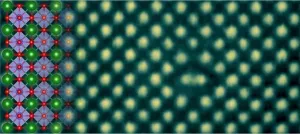
ELSE PRESS RELEASES FROM THIS DATE:
2021-01-15
Osaka, Japan - A team of scientists from Osaka University, The University of Queensland, and the National University of Singapore's Faculty of Engineering used tiny nanodiamonds coated with a heat-releasing polymer to probe the thermal properties of cells. When irradiated with light from a laser, the sensors acted both as heaters and thermometers, allowing the thermal conductivity of the interior of a cell to be calculated. This work may lead to a new set of heat-based treatments for killing bacteria or cancer cells.
Even though the cell is the fundamental unit of all living organisms, some physical properties have remained difficult to study in vivo. For example, a cell's thermal conductivity, as well as the rate that heat can flow through an object if ...
2021-01-15
Berkeley -- Most frogs emit a characteristic croak to attract the attention of a potential mate. But a few frog species that call near loud streams -- where the noise may obscure those crucial love songs -- add to their calls by visually showing off with the flap of a hand, a wave of a foot or a bob of the head. Frogs who "dance" near rushing streams have been documented in the rainforests of India, Borneo, Brazil and, now, Ecuador.
Conservation ecologist Rebecca Brunner, a Ph.D. candidate at the University of California, Berkeley, has discovered that the glass frog ...
2021-01-15
Plant pathologists working at universities across 26 corn-producing states in the United States and in Ontario, Canada, compiled data about annual corn reductions caused by diseases. Estimated loss from each disease varied greatly by region.
"This group of plant pathologists takes a step back to estimate what has gone wrong in corn fields in each of their states," said Iowa State University plant pathologist Daren Mueller, who was involved in this project. "Collectively, and across years, corn disease loss estimates provide folks a zoomed out view of what diseases are affecting corn in the U.S. and Canada."
To Mueller, these data represent one of the pieces of a good research project. Researchers can use these data to justify new research projects that can help mitigate the impacts ...
2021-01-15
The U.S. fishing and seafood sector generated more than $200 billion in annual sales and supported 1.7 million jobs in recent years. It experienced broad declines in 2020 as a result of the COVID-19 public health crisis, according to a new NOAA Fisheries analysis released today. While losses vary by sector, by region and by industry, data and information from this report may help businesses and communities assess losses and inform long-term recovery and resilience strategies.
According to analysts, COVID-19 protective measures instituted in March across the United States and globe contributed to an almost-immediate impact on seafood sector sales. There was a strong start to the year, with ...
2021-01-15
Like a person breaking up a cat fight, the role of catalysts in a chemical reaction is to hurry up the process - and come out of it intact. And, just as not every house in a neighborhood has someone willing to intervene in such a battle, not every part of a catalyst participates in the reaction. But what if one could convince the unengaged parts of a catalyst to get involved? Chemical reactions could occur faster or more efficiently.
Stanford University material scientists led by Jennifer Dionne have done just that by using light and advanced fabrication and characterization techniques to endow catalysts with new abilities.
In a proof-of-concept experiment, rods of palladium that were approximately 1/200th the width of a human hair served as catalysts. ...
2021-01-15
COLUMBIA, Mo. - When he was in middle school, teachers would give Sam Curran a list of words to type in a computer to practice his vocabulary. But Sam, who has autism, was unable to stay focused on the task and required a significant amount of one-to-one direction from a teacher to complete his work. After his mother, Alicia, persuaded his teachers to allow Sam to change the colors of the words, he was able to complete work more independently and began making remarkable progress.
Now 20 years old, Sam's mother continues to ensure his special interests are leveraged in an effort to continue to help him grow and develop. A new survey from the MU Thompson Center for Autism and Neurodevelopmental Disorders has found that similar strategies for children with disabilities can help reduce anxiety ...
2021-01-15
A new Northwestern University-led study is unfolding the mystery of how RNA molecules fold themselves to fit inside cells and perform specific functions. The findings could potentially break down a barrier to understanding and developing treatments for RNA-related diseases, including spinal muscular atrophy and perhaps even the novel coronavirus.
"RNA folding is a dynamic process that is fundamental for life," said Northwestern's Julius B. Lucks, who led the study. "RNA is a really important piece of diagnostic and therapeutic design. The more we know about RNA folding and complexities, the better we can design treatments."
Using data from RNA-folding experiments, the researchers generated the first-ever data-driven movies of how RNA folds as it is made by cellular ...
2021-01-15
Nearly 38 million people around the world are living with HIV, which, with access to treatment, has become a lifelong chronic condition. Understanding how infection changes the brain, especially in the context of aging, is increasingly important for improving both treatment and quality of life.
In January, researchers at the Mark and Mary Stevens Neuroimaging and Informatics Institute (USC Stevens INI), part of the Keck School of Medicine of USC, and other international NeuroHIV researchers, published one of the largest-ever neuroimaging studies of HIV. The researchers pooled magnetic resonance imaging (MRI) data from 1,203 HIV-positive individuals across Africa, ...
2021-01-15
The White-lipped peccary Tayassu pecari is a boar-like hoofed mammal found throughout Central and South America. These animals roam the forest in bands of 50 to 100 individuals, eating a wide variety of foods. In Brazil's Atlantic Rainforest, they prefer the fruit of the jussara palm Euterpe edulis.
The jussara is very abundant in this biome, probably thanks to vast amounts of dung, urine, and soil trampling by peccaries as well as tapirs (Tapirus terrestris) and other fruit-eating animals, or frugivores. This behavior releases forms of nitrogen, a key element in plant growth.
A study supported ...
2021-01-15
Boston - A national group of pediatric addiction medicine experts have released newly-established principles of care for young adults with substance use disorder. Led by the Grayken Center for Addiction at Boston Medical Center, the collection of peer-reviewed papers was developed to guide providers on how to treat young adults with substance use disorder given their age-specific needs, as well as elevate national discussions on addressing these challenges more systematically.
Published in Pediatrics, the 11-paper supplement is the result of a convening of national experts in the treatment of young adults to determine the most important principles to address when caring for this unique population of patients with substance use disorder. ...
LAST 30 PRESS RELEASES:
[Press-News.org] Conductive nature in crystal structures revealed at magnification of 10 million times
University of Minnesota study opens up possibilities for new transparent materials that conduct electricity

